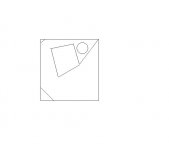Hi!
I have been looking at Lowther's "The Delphic" speaker a while, but I'll never be able to purchase a pair. Found here: www.lowtherloudspeakers.com I own a pair of The Fidelio's now (PM6A's -->going DX3 now), and love them, but can it get better?
The drawings of the Bel Canto and Delphic are not available, but I got permission to change the design of the Fidelio to make the horn exit facing the floor and design my own base. I might choose the Academy for a base start, because the horn look better suited to run to the floor.
The idea is that the base follow a tractrix curve and extend the horn, and even use the floor as a part of the horn. This base is possible to raise or lower to adjust the horn path lenght and the sound after your liking.
Do anyone have a idea of size and tractrix shape it should have? Also, how much clearance from floor to horn mouth? Max/min?
I can see several challenges here:
Reverse-engineer the bass horn-part of the Academy speaker.
Load the data into Hornresp.(or other suiteable application)
Model a round Tractrix shape for the base
Get a promising result.
Create.
Fabricating is less of a problem when all measurements are available. If I got the profile of the base, it's easily machined at work. On the cabinet itself I want to keep the original design just alter the horn exit to work with the base.
Do anyone want to approach the "base-design" and horn exit? If so, I got the drawings and will provide measurements if asked. This is my new 1-3year project to build. I'll possibly do it in this thread later.
Thanks,
I have been looking at Lowther's "The Delphic" speaker a while, but I'll never be able to purchase a pair. Found here: www.lowtherloudspeakers.com I own a pair of The Fidelio's now (PM6A's -->going DX3 now), and love them, but can it get better?
The drawings of the Bel Canto and Delphic are not available, but I got permission to change the design of the Fidelio to make the horn exit facing the floor and design my own base. I might choose the Academy for a base start, because the horn look better suited to run to the floor.
The idea is that the base follow a tractrix curve and extend the horn, and even use the floor as a part of the horn. This base is possible to raise or lower to adjust the horn path lenght and the sound after your liking.
Do anyone have a idea of size and tractrix shape it should have? Also, how much clearance from floor to horn mouth? Max/min?
I can see several challenges here:
Reverse-engineer the bass horn-part of the Academy speaker.
Load the data into Hornresp.(or other suiteable application)
Model a round Tractrix shape for the base
Get a promising result.
Create.
Fabricating is less of a problem when all measurements are available. If I got the profile of the base, it's easily machined at work. On the cabinet itself I want to keep the original design just alter the horn exit to work with the base.
Do anyone want to approach the "base-design" and horn exit? If so, I got the drawings and will provide measurements if asked. This is my new 1-3year project to build. I'll possibly do it in this thread later.
Thanks,
Last edited:
So, got the permission from Lowther to share the drawings with the purpose in mind to reverse-engineer the bass horn. Also alter the cabinet design to fit the base.
Academy overview:
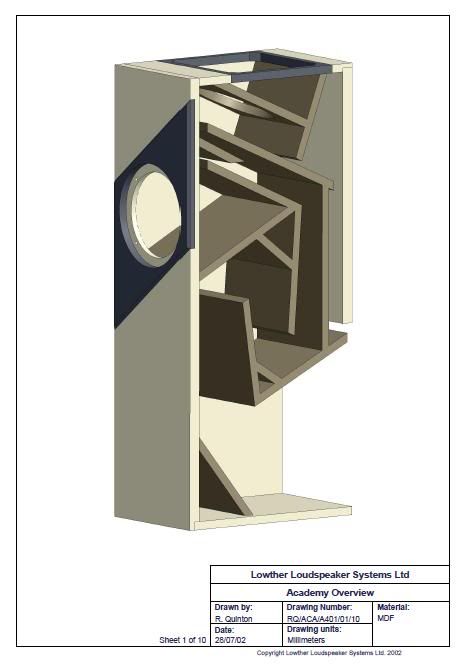
What I want to do, is alter the horn so that it exit down to the ground. Then add a Tractrix curved base to adjust horn lenght and mouth, with a design that will work best with the base and floor.
Academy overview:

What I want to do, is alter the horn so that it exit down to the ground. Then add a Tractrix curved base to adjust horn lenght and mouth, with a design that will work best with the base and floor.
The reason I choose the Academy is, I've been told that the reinforcement in the sound are really good over the Fidelio.
Okay, time to find all the S's.
Academy Internals
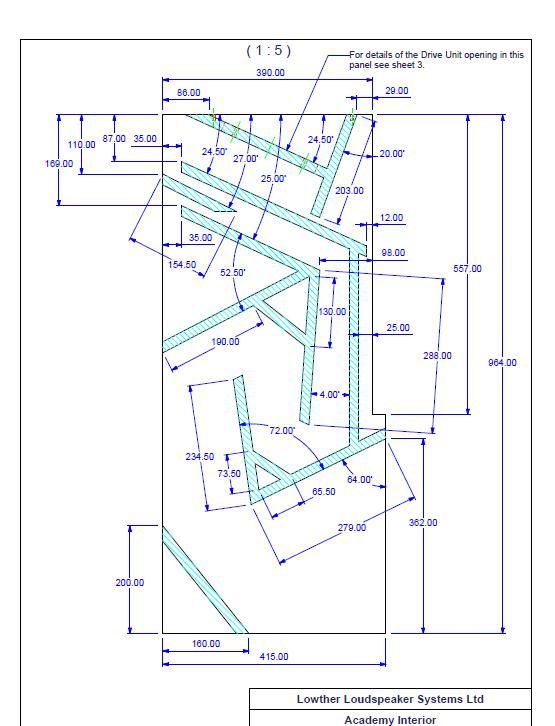
Do anyone got skills in autocad or similar program? I need help analyzing it
All internal panels are 244mm wide and 18mm thick.
Okay, time to find all the S's.
Academy Internals

Do anyone got skills in autocad or similar program? I need help analyzing it
All internal panels are 244mm wide and 18mm thick.
I just located a picture of a speaker that should be the Delphic.
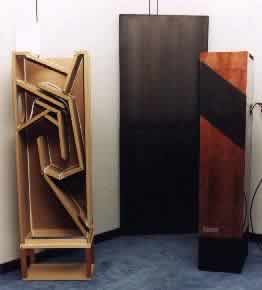
Side-by side with the Academy it look alot like it.
Would love to just use the plans and just move the exit.
Each cabinet will use 2x Lowther DX3 drivers, 15Ohm model in parallel. Hope I get the thiele small parametres for the driver tomorrow.

Side-by side with the Academy it look alot like it.
Would love to just use the plans and just move the exit.
Each cabinet will use 2x Lowther DX3 drivers, 15Ohm model in parallel. Hope I get the thiele small parametres for the driver tomorrow.
Last edited:
...
Reverse-engineer the bass horn-part of the Academy speaker.
Load the data into Hornresp.(or other suiteable application)
Model a round Tractrix shape for the base
...
Have you done the above?
If yes, you'd have found that interesting yet 'inconvinient' truth about bass horn.
For a start, you don't need very precise dimensions everywhere in the horn.
Overall path length (or sectioned to your liking) and mouth size are 2 essential factors. (Also, the overall size of the complete horn is mostly determined by them.) With these 2, you may start seeing how it works.
And then all others parameters can be tuned by the sims. Hornresp is a wonderful and free tool, and would guide you through the sims.
BTW, for bass, tractrix contour is not a good choice. Try hyperbolic or exponetial
maybe think about whether its made smaller to look nicer ?
if your goal is a better horn, there ought to be better options
appears to be a lot of complications with little gain
should I build a backloaded today, I would consider something like this
but may be less fun, I know
if your goal is a better horn, there ought to be better options
appears to be a lot of complications with little gain
should I build a backloaded today, I would consider something like this
but may be less fun, I know
Attachments
That's what I mean 'inconvinient truth' about those commercial designs. I think we shoudn't even call them horns, sort of resonant pipes instead. Bass horn can not be slim and small. That's simply against the physics. (In the photo in #4 post, it seems some kind of mass-load at the 'port'... )
I once back-engineered the Acousta and didn't like what I saw on the sim, so I started over from scratch. That project turned out pretty good, and very big. Full story here: http://www.diyaudio.com/forums/full-range/138094-dilemmas-always-blh-vs-bvr.html
If the tolerable size is restricted by practical reasons, then you'd better give up horn and consider BVR or MLTL instead.
I once back-engineered the Acousta and didn't like what I saw on the sim, so I started over from scratch. That project turned out pretty good, and very big. Full story here: http://www.diyaudio.com/forums/full-range/138094-dilemmas-always-blh-vs-bvr.html
If the tolerable size is restricted by practical reasons, then you'd better give up horn and consider BVR or MLTL instead.
Lew Hardy used a modified Academy cabinet for his "Vavaldi" speakers. IIRC, he used Lowther 55 drivers with custom phase plugs, a VAPS circuit (an EQ/whatever, designed by Dan Wiggins) and a Visiton super tweeter.
It was probably one of the best speakers that I've heard and was capable of excellent bass. We challeged Lew to play a Drum solo disc and it did shake the room. BTW: it was at least 12 feet away from the nearest wall. I have never heard any Lowther based speaker that could do what Lew was able to get out of his design.
[Edit: He was using Bottlehead 2A3 SET monoblock amps, aproximately 3.5 watts]
Best Regards,
TerryO
It was probably one of the best speakers that I've heard and was capable of excellent bass. We challeged Lew to play a Drum solo disc and it did shake the room. BTW: it was at least 12 feet away from the nearest wall. I have never heard any Lowther based speaker that could do what Lew was able to get out of his design.
[Edit: He was using Bottlehead 2A3 SET monoblock amps, aproximately 3.5 watts]
Best Regards,
TerryO
Last edited:
EX3? Evidently I got that wrong, but what I wrote was off the top of my head (so that probably explains it, "Old Timer's Disease").
Just the same it, the Vavaldi was just an excellent sounding and beautifically finished speaker. If I only had the money..............
Best Regards,
TerryO
Have you done the above?
If yes, you'd have found that interesting yet 'inconvinient' truth about bass horn.
For a start, you don't need very precise dimensions everywhere in the horn.
Overall path length (or sectioned to your liking) and mouth size are 2 essential factors. (Also, the overall size of the complete horn is mostly determined by them.) With these 2, you may start seeing how it works.
And then all others parameters can be tuned by the sims. Hornresp is a wonderful and free tool, and would guide you through the sims.
BTW, for bass, tractrix contour is not a good choice. Try hyperbolic or exponetial
No, this is my to-do list. Because my skills with a drawing program is non-existing, that is one of the bigger problems.
I'm not very skilled at Hornresp either, but I'm able to get different results when trying.
I just enter amount of drivers to 2pcs in Hornresp then?
About the base, I want the best design to extend the horn and mouth size and extend the horn using the floor too as a wall of the horn, as far as possible. As I mentioned above, it will be height adjustable.
That adjustable coloumn will come from a couple of office chairs, perfect size for the 60kg cabinet, and it can be rotated by the touch of a finger.
Idea:
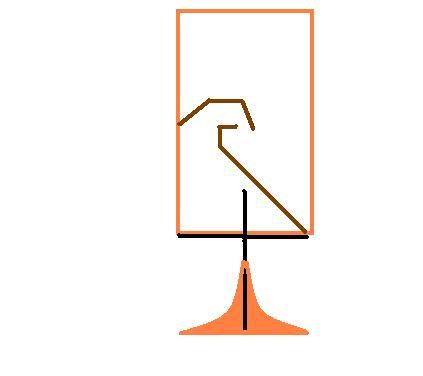
maybe think about whether its made smaller to look nicer ?
if your goal is a better horn, there ought to be better options
appears to be a lot of complications with little gain
should I build a backloaded today, I would consider something like this
but may be less fun, I know
My goal is to make the Academy cabinet better, by copying this Lowther Logic Series Loudspeakers with it's ambince matching system.
Yes, stiff prize, therefore: this project.
NEW INFO:
Got the electrical parametres for the 15ohm DX3 from Lowther today. Free air measurements.

And
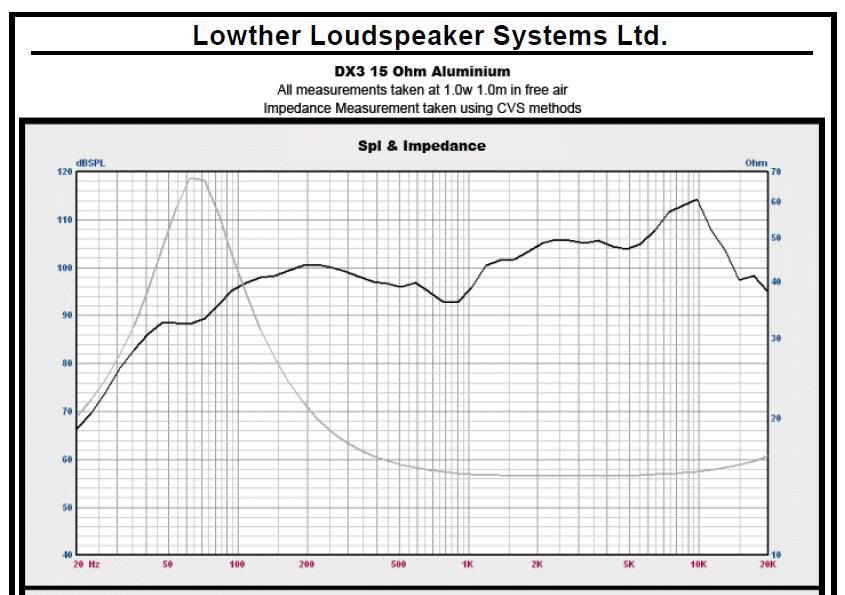
And
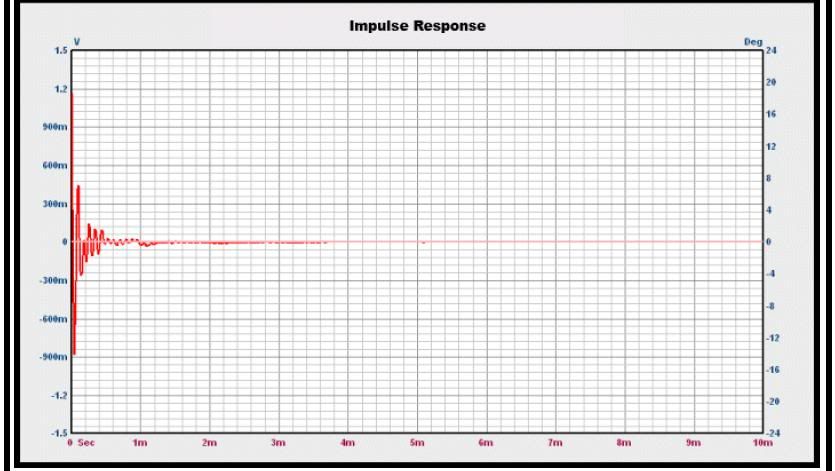
That graph is severely smoothed, obviously. And that hard rising mid-high is the reason I'd like to design a compound horn for it - to load and boost the midrange to avoid that broad dip.
But this might also depend on the foldings and overall design goal. Some horn builder reported that they like to have as much sound as possible coming out of their back loading horn - up into the midrange. Some others don't.
I don't have enough experiences so I'm not so sure myself and think it's complicated and full of tradeoffs...
OTOH, by some experiences of using Hornresp and have some of the sims built, I don't understand the benefit of using 2 fullrangers in one BLH. Maybe I've not tried hard enough. But what I've seen is, with only 1 driver, a proper horn is already VERY big. I don't understand how to squeeze in 2.
As to the floor reflector, it's just part of the horn near the mouth. I think it's very good to have, not very critical in size and shape for itself (compared to back chamber and throat), but it provides possibility of fine tune and probably better load which extends to floor or the entire room.
But this might also depend on the foldings and overall design goal. Some horn builder reported that they like to have as much sound as possible coming out of their back loading horn - up into the midrange. Some others don't.
I don't have enough experiences so I'm not so sure myself and think it's complicated and full of tradeoffs...
OTOH, by some experiences of using Hornresp and have some of the sims built, I don't understand the benefit of using 2 fullrangers in one BLH. Maybe I've not tried hard enough. But what I've seen is, with only 1 driver, a proper horn is already VERY big. I don't understand how to squeeze in 2.
As to the floor reflector, it's just part of the horn near the mouth. I think it's very good to have, not very critical in size and shape for itself (compared to back chamber and throat), but it provides possibility of fine tune and probably better load which extends to floor or the entire room.
Last edited:
the floor reflector, I dont think it will act as a mouth as such, but it might influence the "pi" value quite a bit, giving a larger coupling area
but Im guessing
btw
join, you last drawing looks more like a BVR than a horn
we have a couple of experts on that
and quite many build them too
but Im guessing
btw
join, you last drawing looks more like a BVR than a horn
we have a couple of experts on that
and quite many build them too
the floor reflector, I dont think it will act as a mouth as such....
Why not?
I even think the actual mouth is hard to defined clearly when a horn is placed closed enough to boudaries and the expansion is reasonably continous.
Take K-horn, one of the most famous corner horn, where exactly is its mouth? Where does it end? Maybe it's the doorway at the far side of the room.
Hmm, do you want to explain a little further?Ohh boy...
That graph is severely smoothed, obviously. And that hard rising mid-high is the reason I'd like to design a compound horn for it - to load and boost the midrange to avoid that broad dip.
But this might also depend on the foldings and overall design goal. Some horn builder reported that they like to have as much sound as possible coming out of their back loading horn - up into the midrange. Some others don't.
I was hoping to keep outside dimensions of the cabinet, but I'm more or less flexible on internals, for the best result within limits.
What would you suggest to do inside of this cabinet?
OTOH, by some experiences of using Hornresp and have some of the sims built, I don't understand the benefit of using 2 fullrangers in one BLH. Maybe I've not tried hard enough. But what I've seen is, with only 1 driver, a proper horn is already VERY big. I don't understand how to squeeze in 2.
They did it in the Academy cabinet. I was told the reinforcement was really good, and the top driver is reflecting sound on the back wall/ceiling. I have no personal experience.
Hopefully I get a guy at work to help me find he horn length an S's on the Academy, model it in a simulator to check the response. But I'm not sure of how to attack the two back-chambers and seperate paths before they go together. And the small opening in the back, a transmission line?
Is it possible to simulate the complete speaker? Is it needed?
If WAF did not apply here, I would have been been listening to a pair of Hedlund horns now!
I was hoping the floor reflector would increase horn length and make it go lower in frequenzy thn the 40Hz they are listing the Academy at.As to the floor reflector, it's just part of the horn near the mouth. I think it's very good to have, not very critical in size and shape for itself (compared to back chamber and throat), but it provides possibility of fine tune and probably better load which extends to floor or the entire room.
I was hoping the floor reflector would increase horn length and make it go lower in frequenzy thn the 40Hz they are listing the Academy at.
it does, by the "pi" factor
as any boundry close the actual mouth, floor, walls, ceiling, denpending on design and how its placed
the actual "pi" factor seems to be your key
and having the floor all around the mouth opening you might get significant low end support, maybe
it does, by the "pi" factor
as any boundry close the actual mouth, floor, walls, ceiling, denpending on design and how its placed
the actual "pi" factor seems to be your key
and having the floor all around the mouth opening you might get significant low end support, maybe
Is it possible to simulate that situation? Is Hornresp or AkAbak the best program to use?
OTOH, by some experiences of using Hornresp and have some of the sims built, I don't understand the benefit of using 2 fullrangers in one BLH. Maybe I've not tried hard enough. But what I've seen is, with only 1 driver, a proper horn is already VERY big. I don't understand how to squeeze in 2.
As to the floor reflector, it's just part of the horn near the mouth. I think it's very good to have, not very critical in size and shape for itself (compared to back chamber and throat), but it provides possibility of fine tune and probably better load which extends to floor or the entire room.
CLS,
As some others have mentioned, the Pi, or boundary effect of a floor level horn mouth effectively doubles the area of the mouth's real size. It also prevents timing issues that result from floor bounce and allows a bit of bass extension.
Likewise, the use of the two drivers in the Acedemy design allows for some "air" in the treble as well as increased sound pressure levels. Probably the major benefit, is that the design allows you to avoid the need for Baffle Step Circuitry which would require attenuating the overall output (above the baffle step frequency) by anywhere from 3 to 4 dB.
It's quite an elegant solution, IMHO.
Here's a picture of the Best Sound in Show system from 2008 VSAC that shows the use of the Mirror Effect on a horn's mouth:
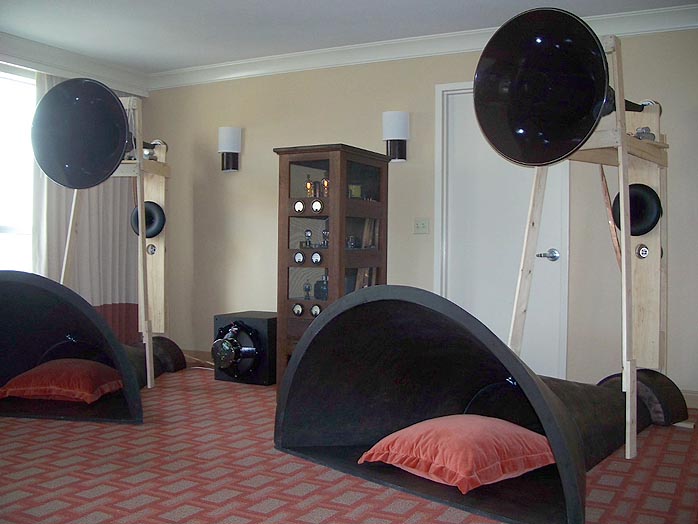
Best Regards,
TerryO
Last edited:
- Status
- This old topic is closed. If you want to reopen this topic, contact a moderator using the "Report Post" button.
- Home
- Loudspeakers
- Full Range
- Designing a tractrix shape for horn speaker base.
